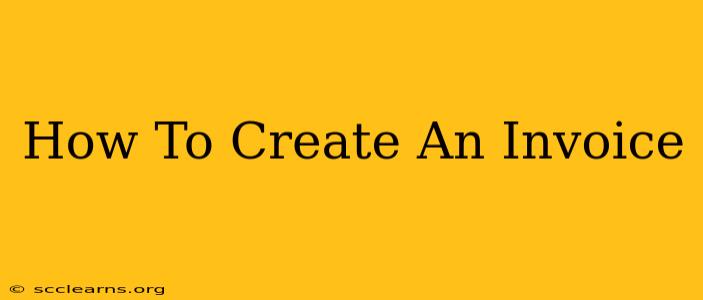Creating professional invoices is crucial for any business, big or small. A well-designed invoice not only ensures you get paid on time but also projects a professional image to your clients. This comprehensive guide will walk you through the process of creating an invoice, from the essential information to include to the best practices for efficient invoicing.
What is an Invoice?
An invoice is a commercial document issued by a seller to a buyer, indicating the products or services provided, their costs, and payment terms. It serves as a formal request for payment and a record of the transaction for both parties. Think of it as a receipt before you receive payment.
Essential Information for Your Invoice
A professional invoice needs several key pieces of information. Missing even one can lead to delays in payment. Let's break it down:
1. Invoice Number:
- Why it's important: Uniquely identifies each invoice, making it easy to track and reference.
- Best practice: Use a sequential numbering system (e.g., 1001, 1002, 1003...).
2. Invoice Date:
- Why it's important: Specifies the date the invoice was issued.
- Best practice: Use the current date.
3. Your Business Information:
- Why it's important: Clearly identifies you as the seller.
- What to include: Your business name, address, phone number, email address, and tax ID number (if applicable).
4. Client Information:
- Why it's important: Identifies the buyer and ensures the invoice reaches the correct person.
- What to include: Client's name, address, and any relevant contact information.
5. Invoice Due Date:
- Why it's important: Sets a clear expectation for payment.
- Best practice: Specify a reasonable timeframe, usually 15-30 days.
6. Description of Goods or Services:
- Why it's important: Details the items or services provided.
- Best practice: Be clear, concise, and specific. Include quantity, unit price, and total cost for each item.
7. Payment Terms:
- Why it's important: Outlines the acceptable payment methods (e.g., check, credit card, online transfer).
- Best practice: Clearly state any penalties for late payments.
8. Total Amount Due:
- Why it's important: The final sum the client needs to pay.
- Best practice: Clearly highlight this amount.
9. Your Business Logo (Optional):
- Why it's important: Adds a professional touch and reinforces your brand identity.
Methods for Creating Invoices
You have several options for creating invoices:
-
Invoicing Software: Software like FreshBooks, Xero, or QuickBooks offer automated invoicing, expense tracking, and other accounting features. These are excellent for businesses of all sizes.
-
Spreadsheet Software: Programs like Microsoft Excel or Google Sheets allow you to create custom invoice templates. This option offers more control over design but requires more manual effort.
-
Invoice Generators: Numerous online invoice generators offer free or paid templates to create invoices quickly.
Best Practices for Professional Invoices
- Keep it clean and simple: Avoid cluttered designs. Use a professional font and clear formatting.
- Use a consistent format: Maintain a consistent style for all invoices.
- Send invoices promptly: Issue invoices as soon as the goods or services are delivered.
- Include your payment details clearly: Make it easy for the client to pay.
- Follow up on overdue invoices: Send polite reminders to clients with outstanding payments.
Creating professional invoices is a fundamental aspect of running a successful business. By following these steps and best practices, you can ensure efficient payment collection and maintain a positive relationship with your clients. Remember, a well-crafted invoice is a reflection of your professionalism and helps ensure your business thrives.

